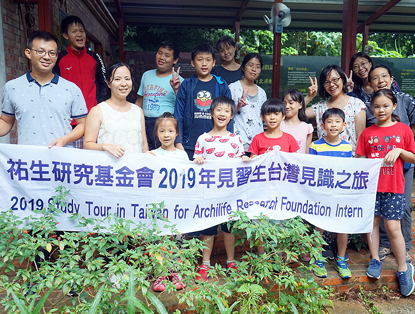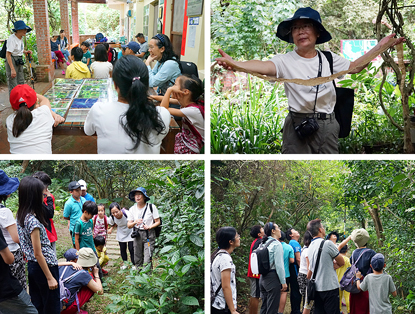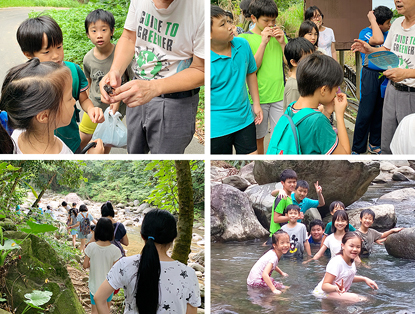Sketch of Archilife Study Tour, June 2019
|
2019年6月份見識之旅縮影  6月份見識之旅活動,於2019年6月22日由呂明澐小姐帶領13位祐生見習生及家長們,進行石門阿里磅生態暨溪遊探索之旅。出發當日天氣晴朗,見習生們及其家長皆準時集合並出發。活動開始之初,領隊呂明澐小姐提醒本次活動注意事項及觀察重點,先行建立見習生的背景知識。 6月份見識之旅活動,於2019年6月22日由呂明澐小姐帶領13位祐生見習生及家長們,進行石門阿里磅生態暨溪遊探索之旅。出發當日天氣晴朗,見習生們及其家長皆準時集合並出發。活動開始之初,領隊呂明澐小姐提醒本次活動注意事項及觀察重點,先行建立見習生的背景知識。For the study tour of June 22, 2019, Ms Lu Ming-yun led 13 ARF interns and their parents to Shimen to discover the ecological environment at Alibang Ecological Farm and play in the creek. It was sunny on the day of tour, and the interns and their parents were on time for the departure. It was clear and sunny on the day of the tour, and the interns and their parents were on time for the departure. At the start of the day's activities, team leader Ms. Lu Ming-yun reminded everyone about things to note and what to observe, and gave the interns some background knowledge.  本次行程參訪位於新北市石門區的阿里磅生態農場,該農場由60個家庭集資購地成立,多年來秉持「自然復育、低度開發」的原則,地貌生態保存十分完整,經年累月的自然演替下,發展出高歧異度的生態相,其中蛙類更高達19種,為夏季夜間賞蛙的好去處。行程一開始,由退休教師王素珍女士介紹農場起緣及豐富的生態環境,說明阿里磅是該地區的舊稱,早期因盛產馬藍(大菁)而成為染布重地,「阿里磅」即平埔族語「染布坊」的意思。接著述說農場設立初衷,鼓勵見習生透過觀察、傾聽、觸摸等感官體驗認識動植物,進而愛護大自然,並取出完整的蛇蛻讓見習生以上述方式近距離接觸,亦為眾人建立戶外觀察的基本觀念。隨後前往生態步道進行導覽,王老師沿途解說所見昆蟲及植物,其中特別以圖卡教導眾人蜻蜓與豆娘的辨別方式,以及蝴蝶與蛾類之間的主要差異,並提及在野外若要辨識芋頭和姑婆芋,可觀察水在葉子上的狀態,前者會形成一顆顆水珠,後者則否,強調姑婆芋全株有毒不可食用,然早期肉販多以姑婆芋葉片包裹肉塊,但只要注意不沾到葉片汁液並洗淨即無礙,比較現今使用塑膠製品包裝相對環保。 本次行程參訪位於新北市石門區的阿里磅生態農場,該農場由60個家庭集資購地成立,多年來秉持「自然復育、低度開發」的原則,地貌生態保存十分完整,經年累月的自然演替下,發展出高歧異度的生態相,其中蛙類更高達19種,為夏季夜間賞蛙的好去處。行程一開始,由退休教師王素珍女士介紹農場起緣及豐富的生態環境,說明阿里磅是該地區的舊稱,早期因盛產馬藍(大菁)而成為染布重地,「阿里磅」即平埔族語「染布坊」的意思。接著述說農場設立初衷,鼓勵見習生透過觀察、傾聽、觸摸等感官體驗認識動植物,進而愛護大自然,並取出完整的蛇蛻讓見習生以上述方式近距離接觸,亦為眾人建立戶外觀察的基本觀念。隨後前往生態步道進行導覽,王老師沿途解說所見昆蟲及植物,其中特別以圖卡教導眾人蜻蜓與豆娘的辨別方式,以及蝴蝶與蛾類之間的主要差異,並提及在野外若要辨識芋頭和姑婆芋,可觀察水在葉子上的狀態,前者會形成一顆顆水珠,後者則否,強調姑婆芋全株有毒不可食用,然早期肉販多以姑婆芋葉片包裹肉塊,但只要注意不沾到葉片汁液並洗淨即無礙,比較現今使用塑膠製品包裝相對環保。Alibang Ecological Farm at Shimen, New Taipei City, was built from funds pooled together by 60 families. For years, it has maintained the principle of "ecological restoration and low level of development", keeping its landform and ecosystem intact, and developing high biodiversity. The farm boasts up to 19 frog species, making it a great place to observe frogs on summer nights. The tour started with an introduction to the origin of the farm and its diverse ecological environment by a retired teacher, Madam Wang Su-chen. She explained that Alibang is the old name of the area. It became an important place for fabric dyeing in the early days due to its bounteous production of Strobilanthes cusia. "Alibang" means "dye workshop" in the language of the Pepo tribe. Speaking on the initial objective for building the farm, Madam Wang encouraged the interns to get to know plants and animals through observation, listening and touch, and learn about caring for nature. She then took out the complete shed skin of a snake to allow the interns to get up close to it using the above methods, and established the basic concept of outdoor observation. During the guided tour on the ecological trail next, Madam Wang introduced the insects and plants seen along the way. Using picture cards, she taught everyone how to differentiate between dragonfly and damselfly, and the main differences between a butterfly and a moth. She also mentioned that, to differentiate between taro and giant taro in the wild, one can observe the state of water on their leaves. Water will form little droplets on the leaf of the taro plant but not on that of the giant taro. In the early days, butchers would wrap pieces of meat in giant taro leaves. It is safe as long as the juice of the leaves does not come into contact with the meat and the meat is washed well. In fact, it is more eco-friendly than the use of plastic packaging today.  午餐享用取材自當地的家常菜餚。飯後,前往農場附近的阿里磅溪進行溪遊探索,由農場主人王德昌先生擔任導覽老師,沿途解說周邊生態及阿里磅溪相關知識,因阿里磅受東北季風吹拂影響,雨量大多集中在冬季,枯、豐水期明顯,適合夏季探訪。隨即提醒眾人一般溪遊應注意事項,包括天候狀況、溪遊前二日降雨量、水流湍急程度及垃圾不落地等。抵達目的地之後,見習生即下水尋找底棲生物,由於清冽乾淨的水質,提供生物良好的生長空間,亦證明其上游土地覆蓋良好、生態環境優良。至此,本日活動已近尾聲,大家一起合照留念後搭車返程,並期待於下次見識之旅再相見。 午餐享用取材自當地的家常菜餚。飯後,前往農場附近的阿里磅溪進行溪遊探索,由農場主人王德昌先生擔任導覽老師,沿途解說周邊生態及阿里磅溪相關知識,因阿里磅受東北季風吹拂影響,雨量大多集中在冬季,枯、豐水期明顯,適合夏季探訪。隨即提醒眾人一般溪遊應注意事項,包括天候狀況、溪遊前二日降雨量、水流湍急程度及垃圾不落地等。抵達目的地之後,見習生即下水尋找底棲生物,由於清冽乾淨的水質,提供生物良好的生長空間,亦證明其上游土地覆蓋良好、生態環境優良。至此,本日活動已近尾聲,大家一起合照留念後搭車返程,並期待於下次見識之旅再相見。After lunch, which was classic home dishes made from local ingredients, everyone headed to Alibang Creek. Farm owner Mr. Wang Te-chang was the tour guide. On the way, he introduced the surrounding ecosystem and facts about the Alibang Creek. Due to the effect of the northeastern monsoon, rain is most intensive in winter and significantly less during the rest of the year, making it most suitable for fieldtrips in summer. Mr. Wang then reminded everyone about general precautions when playing in the creek, including the weather, rainfall two days before, speed of water flow and not littering. On arrival at the destination, the interns went into the water in search of bottom-dwelling organisms. The clean water provides excellent environment for the organisms to thrive. It is also a testimony of excellent land cover upstream and good ecological environment. At this point, the day's itinerary came to an end. Everyone took a group photo before heading back and looked forward to the next study tour. |

